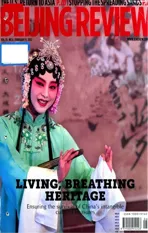Preserving Cultural Identity
2012-12-21本刊编辑部
Preserving Cultural Identity
Late last year, at a meeting of UNESCO’s Intergovernmental Committee for the Safeguarding of the Intangible Cultural Heritage in Bali, Indonesia,China’s traditional shadow puppetry was included in the Representative List of the Intangible Cultural Heritage of Humanity.
This is good news, not only because this long-standing and beautiful art form has now been recognized by the global community, but also because it symbolizes China’s broader contribution to enriching the world’s culture.
Intangible culture forms an integral part of a country’s heritage. Having its origins largely in the daily or spiritual lives of people, intangible culture,like its tangible counterpart, often re fl ects the values, as well as the creative and imaginative capacity of a nation. It should therefore be duly protected so that a nation’s distinct cultural identity will be maintained and carried on into the future.
As a country with more than 5,000 years of history, China boasts numerous intangible cultural treasures, ranging from folk art and handicrafts to traditional medicine and social rituals and customs. Over the years, the Chinese Government has spared no effort to protect the country’s intangible as well as tangible heritage. Authorities have passed legislation, introduced regulations and allocated special funding in order to keep invaluable traditions alive.
Despite these efforts, many intangible cultural items still face a number of dif fi culties. A shortage of capital, lack of determined and quali fi ed successors, ineffective protection measures, a lack of awareness and sheer neglect mean that many treasures have either fallen into oblivion or are on the verge of extinction.
Far more effort needs to be made to preserve and protect China’s intangible cultural traditions. Apart from the conventional approaches of increased government funding and more effective enforcement of protective measures, one of the top priorities should be the launch of comprehensive education campaigns. Society as a whole needs to be made aware of the importance of preserving traditional art forms, skills and techniques.
School children, in particular, should be taught to cherish these cultural treasures. As far as possible, children and young people should be given the opportunity to learn and participate in the crafts, art forms, performances and rituals that comprise the nation’s intangible heritage.
Only the active involvement of young people and the broad awareness of society as a whole will keep China’s heritage alive, and allow Chinese society and the world to bene fi t from these unique cultural forms for generations to come.
